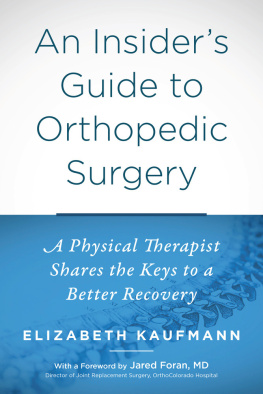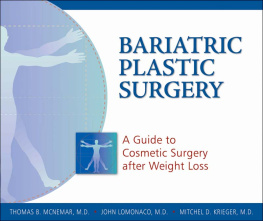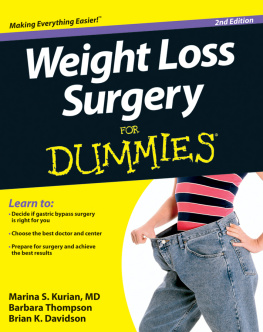Hip Replacement
A Johns Hopkins Press Health Book
Orthopedic Patient Education
Adam E. M. Eltorai, PhD, and Alan H. Daniels, MD, Series Editors
Hip Replacement
EXPERTS ANSWER YOUR QUESTIONS
Edited by
Adam E. M. Eltorai, PhD
Alan H. Daniels, MD
Derek R. Jenkins, MD
Lee E. Rubin, MD

2019 Johns Hopkins University Press
All rights reserved. Published 2019
Printed in the United States of America on acid-free paper
9 8 7 6 5 4 3 2 1
Johns Hopkins University Press
2715 North Charles Street
Baltimore, Maryland 21218-4363
www.press.jhu.edu
Library of Congress Cataloging-in-Publication Data
Names: Eltorai, Adam E. M., editor.
Title: Hip replacement : experts answer your questions / edited by Adam E. M. Eltorai, PhD, Alan H. Daniels, MD, Derek R. Jenkins, MD, and Lee E. Rubin, MD.
Description: Baltimore : Johns Hopkins University Press, 2019. | Series: Orthopedic patient education | A Johns Hopkins Press Health Book | Includes index.
Identifiers: LCCN 2018039698 | ISBN 9781421429571 (hardcover : alk. paper) | ISBN 1421429578 (hardcover : alk. paper) | ISBN 9781421429588 (pbk. : alk. paper) | ISBN 1421429586 (pbk. : alk. paper) | ISBN 9781421429595 (electronic) | ISBN 1421429594 (electronic)
Subjects: LCSH: Total hip replacementSurgeryPopular works. | Hip jointSurgeryPopular works.
Classification: LCC RD549 .H56 2019 | DDC 617.5/810592dc23
LC record available at https://lccn.loc.gov/2018039698
A catalog record for this book is available from the British Library.
Special discounts are available for bulk purchases of this book. For more information, please contact Special Sales at 410-516-6936 or .
Johns Hopkins University Press uses environmentally friendly book materials, including recycled text paper that is composed of at least 30 percent post-consumer waste, whenever possible.
PREFACE
Every day in our medical offices, patients and their families ask great questions, eager to learn more about their hip condition. Patients want to know more about their symptoms, diagnoses, alternatives to surgery, when surgery is necessary, preparation for surgery, and recovery from surgery. Much of the currently available health information can be hard to access or comes from sources of dubious quality. There is a need for a practical, evidence-based source of information tailored specifically for the patient.
With elective surgery, patients are interested in gathering information to help choose the best course of treatment for themselves or their family members. This book is intended to serve as a complete guide for patients. The focus is on the patient experience, outlining the process, and anticipating and answering commonly asked questions. We include patient stories to help familiarize the experience of having hip pain, getting a diagnosis, and deciding on treatment. We use examples to explain everything patients want to know about their condition and all the available management options in order to help them determine the right treatment path for them.
The goal of this book is to make complex information accessible to our patients. We hope that this book serves as a resource that individuals can use when they have questions. Moreover, we hope that this book quells some of the natural anxieties and fears that patients might have when considering a hip replacement.
we explain care after you leave the hospital. This chapter covers topics such as pain management, diet, and rehabilitation protocols. We hope that this book helps you to make the decision of whether to get a total hip replacement and, if you decide to go ahead with the surgery, that it will explain clearly what to expect from the surgery and recovery.
Hip Replacement
CHAPTER 1
Overview of Hip Arthritis
Dominic T. Kleinhenz, MD, and Valentin Antoci, Jr., MD, PhD
Hip arthritis is wear and tear of the hip joint that occurs over time. Knowing the anatomy of the hip joint and hip arthritis can help you better understand why your hip arthritis hurts and how a hip replacement can help you. There are multiple causes of hip arthritis, which are explained in this chapter. People with hip arthritis usually see a doctor for hip pain, stiffness, or a combination of pain and stiffness. They may also see a doctor because they have lost the capacity to walk, to use stairs, or to do things that are required for basic daily activities and quality of life.
We will go through the ways that the surgeon evaluates you prior to hip replacement surgery. At the initial visit with your orthopedic surgeon, the doctor will work to confirm that hip arthritis is in fact the source of your hip pain. Before going forward with hip replacement surgery, you need to try nonsurgical strategies to manage your pain and stiffness. Anti-inflammatory medication, physical therapy, injections, and use of a cane or walker may provide enough relief to prevent surgery altogether. Your surgeon will talk to you about prior medical conditions, medications, surgeries, and allergies to get a better understanding of your health so your surgery will be as safe as possible.
What Is Arthritis?
Arthritis is not a single disease. It is a term used to refer to wear and tear of our joints over time, which causes damage to the normally smooth, slippery covering of the joint (cartilage). There are three main types of arthritis: osteoarthritis (OA), inflammatory arthritis, such as rheumatoid arthritis (RA), and post-traumatic arthritis. OA is the most common type of arthritis and occurs slowly over time due to repetitive stress on the joint. OA can affect any joint and leads to erosion of the protective cartilage. This in turn may lead to roughening of the surface, increased friction, bone-on-bone contact, growth of new bone (known as osteophytes or bone spurs), and even loose pieces of bone or tissue floating in the joint, making pain worse or causing mechanical locking, clicking, or catching. Because OA is typically the result of damage over time, it mostly affects patients age 40 and older. However, certain people are genetically predisposed to OA and may develop it at an earlier age.

FIGURE 1.1 Hip joint osteoarthritis: a healthy hip joint compared to a joint with osteoarthritis
The amount of hip arthritis seen on your X-rays does not necessarily correlate to the amount of pain you are having. Two patients with the same hip X-rays may have different pain levels and different responses to nonsurgical treatment. Doctors like to say that they operate on patients, not X-rays. If your X-rays show bone on bone arthritis but you are already getting good pain relief with anti-inflammatory medications, physical therapy, or using a cane or walker, it may not be a good time for surgery. But even if you dont have bone-on-bone arthritis, if you are no longer getting pain relief from things that previously helped, it may be time to go forward with surgery.
Diseases that affect joints are called arthropathies. Inflammatory arthropathies, such as RA, are caused by autoimmune disorders in which the bodys own immune system attacks joints, causing them to deteriorate. It typically involves multiple joints. In addition to affecting the cartilage, autoimmune diseases cause overgrowth of the lining of the joint, the synovium, which contributes to additional pain and swelling. RA is a systemic disease that affects the whole body. It will typically involve the medical care of a rheumatologist, who will prescribe and manage powerful medications, in addition to surgical care from an orthopedist.
Next page









